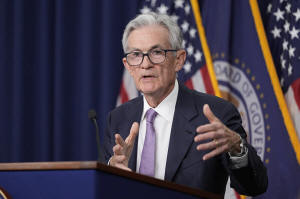Federal Reserve signals end to inflation fight with a sizable half-point
rate cut
 Send a link to a friend
Send a link to a friend
 [September 19, 2024] By
CHRISTOPHER RUGABER [September 19, 2024] By
CHRISTOPHER RUGABER
WASHINGTON (AP) — The Federal Reserve on Wednesday cut
its benchmark interest rate by an unusually large half-point, a dramatic
shift after more than two years of high rates that helped tame inflation
but also made borrowing painfully expensive for American consumers.
The rate cut, the Fed’s first in more than four years, reflects its new
focus on bolstering the job market, which has shown clear signs of
slowing. Coming just weeks before the presidential election, the Fed’s
move also has the potential to scramble the economic landscape just as
Americans prepare to vote.
The central bank’s action lowered its key rate to roughly 4.8%, down
from a two-decade high of 5.3%, where it had stood for 14 months as it
struggled to curb the worst inflation streak in four decades. Inflation
has tumbled from a peak of 9.1% in mid-2022 to a three-year low of 2.5%
in August, not far above the Fed’s 2% target.
The Fed’s policymakers also signaled that they expect to cut their key
rate by an additional half-point in their final two meetings this year,
in November and December. And they envision four more rate cuts in 2025
and two in 2026.
In a statement and in a news conference with Chair Jerome Powell, the
Fed came closer than it has before to declaring victory over inflation.

“We know it is time to recalibrate our (interest rate) policy to
something that’s more appropriate given the progress on inflation,”
Powell said. "We’re not saying, ‘mission accomplished’ ... but I have to
say, though, we’re encouraged by the progress that we have made.”
“The U.S. economy is in a good place," he added, "and our decision today
is designed to keep it there.”
Though the central bank now believes inflation is largely defeated, many
Americans remain upset with still-high prices for groceries, gas, rent
and other necessities. Former President Donald Trump blames the
Biden-Harris administration for sparking an inflationary surge. Vice
President Kamala Harris, in turn, has charged that Trump’s promise to
slap tariffs on all imports would raise prices for consumers even
further.
Rate cuts by the Fed should, over time, lead to lower borrowing costs
for mortgages, auto loans and credit cards, boosting Americans’ finances
and supporting more spending and growth. Homeowners will be able to
refinance mortgages at lower rates, saving on monthly payments, and even
shift credit card debt to lower-cost personal loans or home equity
lines. Businesses may also borrow and invest more. Average mortgage
rates have already dropped to an 18-month low of 6.2%, according to
Freddie Mac, spurring a jump in demand for refinancings.
“It’s a step in the right direction,” Laura Rosner-Warburton, senior
economist of MacroPolicy Perspectives, said of Wednesday's Fed move.
The additional rate cuts it indicated it will make, she said, will
“prevent risks from building and the unemployment rate from rising. They
are trying to keep the economy in good shape.”
In an updated set of projections, the policymakers collectively envision
a faster drop in inflation than they did three months ago but also
higher unemployment. They foresee their preferred inflation gauge
falling to 2.3% by year’s end, from its current 2.5%, and to 2.1% by the
end of 2025. And they now expect the unemployment rate to rise further
this year, to 4.4%, from 4.2% now, and to remain there by the end of
2025. That’s above their previous forecasts of 4% for the end of this
year and 4.2% for 2025.
Powell was pressed at his news conference about whether the Fed’s
decision to cut its key rate by an unusually large half-point is an
acknowledgement that it waited too long to begin reducing borrowing
rates.

[to top of second column] |

Federal Reserve Board Chairman Jerome Powell speaks during a news
conference at the Federal Reserve in Washington, Wednesday, Sept.
18, 2024. (AP Photo/Ben Curtis)

“We don’t think we’re behind,” he replied. “We think this
is timely. But I think you can take this as a sign of our commitment not
to get behind. We’re not seeing rising (unemployment) claims, not seeing
rising layoffs, not hearing from companies that that’s something that’s
going to happen.”
He added: “There is thinking that the time to support the labor market
is when it’s strong and not when you begin to see the layoffs. We don’t
think we need to see further loosening in labor market conditions to get
inflation down to 2%.”
The Fed’s next policy meeting is Nov. 6-7 — immediately after the
presidential election. By cutting rates this week, soon before the
election, the Fed is risking attacks from Trump, who has argued that
lowering rates now amounts to political interference. Yet Politico has
reported that even some key Senate Republicans who were interviewed
expressed support for a Fed rate cut this week.
Powell pushed back against any suggestion that the Fed shouldn't cut
rates so close to an election.
“We’re not serving any politician, any political figure, any cause, any
issue,” he said. "It’s just maximum employment and price stability on
behalf of all Americans. And that’s how the other central banks are set
up, too. It’s a good institutional arrangement, which has been good for
the public, and I hope and strongly believe that it will continue.”
Powell’s characterization of the economy as fundamentally healthy, with
inflation under control and employment stable but likely to benefit from
rate cuts was an unspoken rebuttal to Trump’s warnings that an economic
disaster is near.
The Fed's move Wednesday reverses the inflation-fighting effort it
engineered by raising its key rate 11 times in 2022 and 2023. Wage
growth has since slowed, removing a potential source of inflationary
pressure. And oil and gas prices are falling, a sign that inflation
should continue to cool in the months ahead. Consumers are also pushing
back against high prices, forcing such companies as Target and
McDonald’s to dangle deals and discounts.
The Fed’s decision drew the first dissent from a member of its governing
board since 2005. Michelle Bowman, a board member who has expressed
concern in the past that inflation had not been fully defeated, said she
would have preferred a quarter-point rate cut.
But the Fed's policymakers as a whole appear to recognize that after
years of strong job growth, employers have slowed hiring, and the
unemployment rate has risen nearly a full percentage point from its
half-century low in April 2023 to a still-low 4.2%. Once unemployment
rises that much, it tends to keep climbing.

At the same time, the officials and many economists have noted that the
rise in unemployment this time largely reflects an influx of people
seeking jobs — notably new immigrants and recent college graduates —
rather than layoffs.
The Fed’s attention now is “preserving the health of the labor market
and preventing unnecessary damage to the economy from a pretty
restrictive (interest rate) stance,” said Rubeela Farooqi, chief U.S.
economist at High Frequency Economics.
___
AP Writers Alex Veiga in Los Angeles, Paul Wiseman and Josh Boak in
Washington and Stan Choe in New York contributed to this report.
All contents © copyright 2024 Associated Press. All rights reserved |